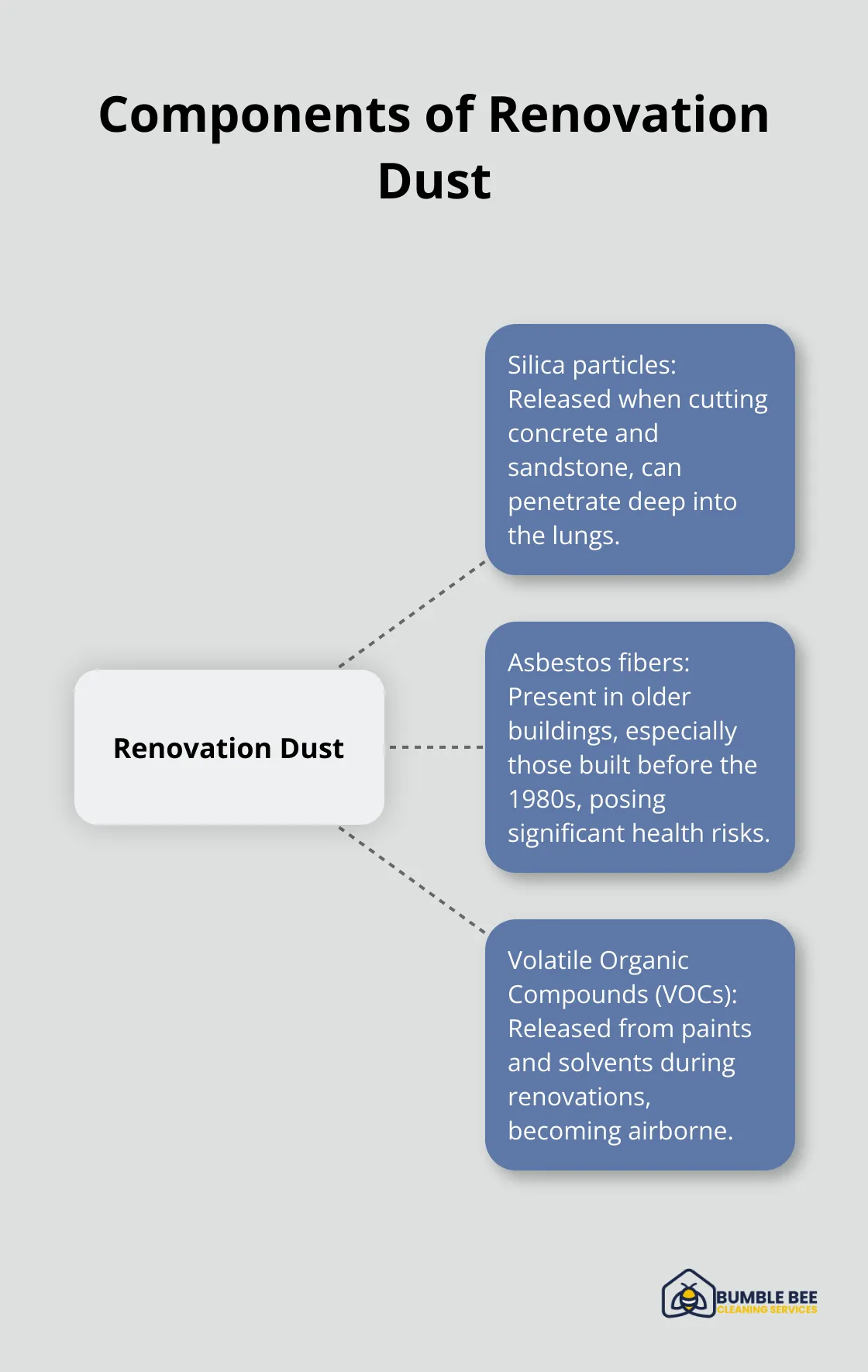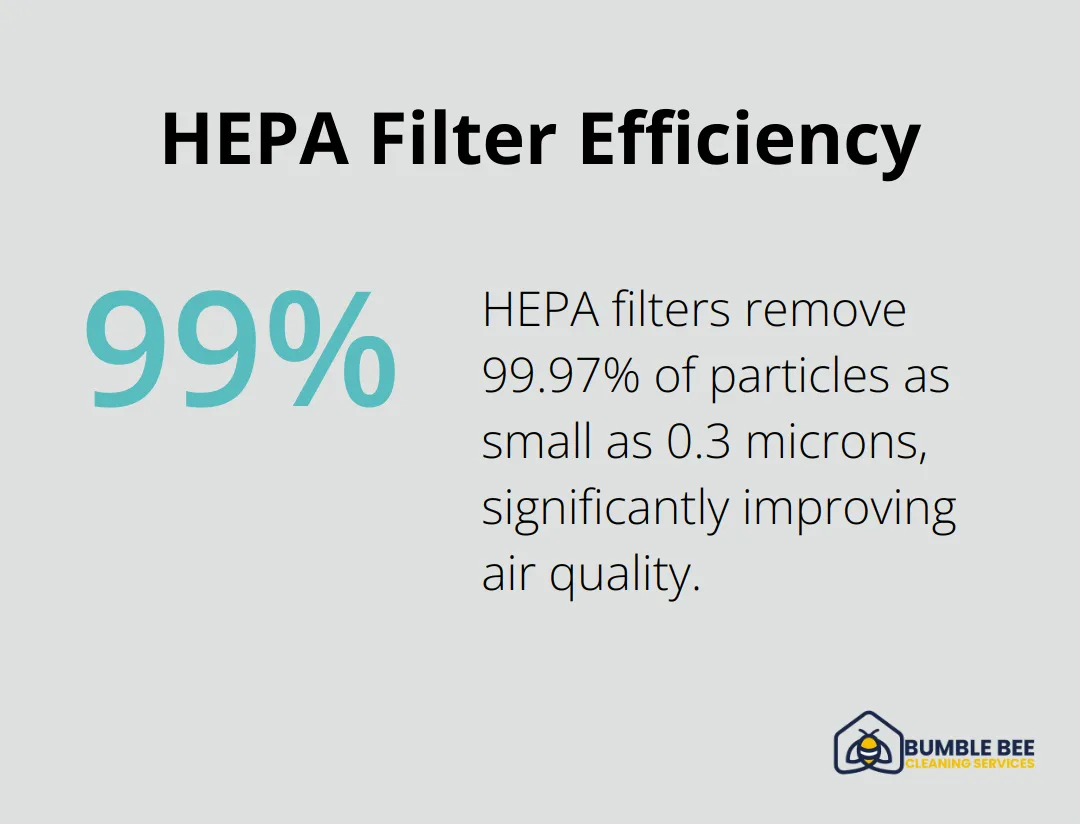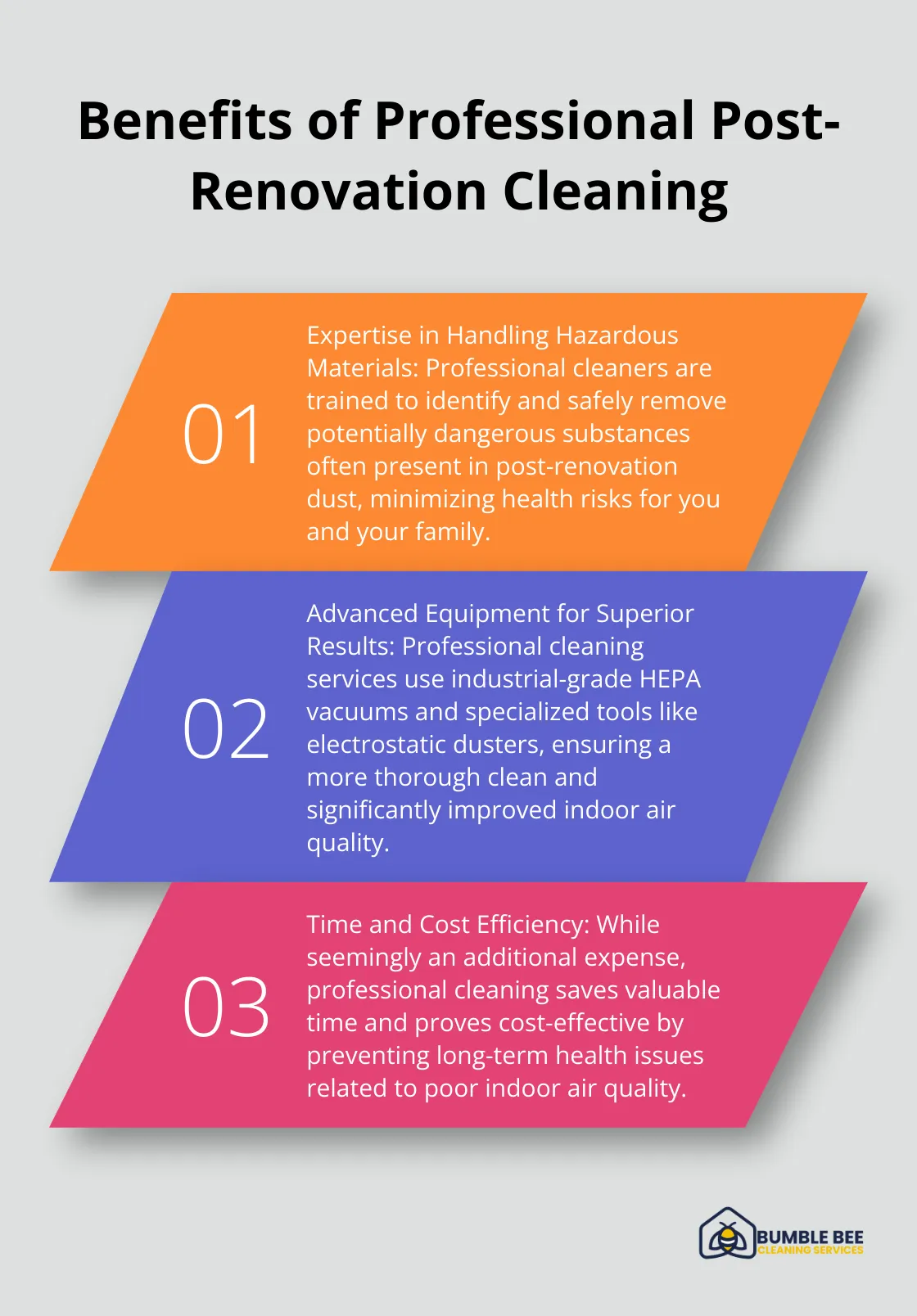Renovations can transform your living space, but they often leave behind a hidden menace: dust. At Bumble Bee Cleaning Services, we understand the importance of thorough construction dust removal to protect your health and home.
Post-renovation dust isn’t just a nuisance; it can pose serious health risks if not properly addressed. In this blog post, we’ll explore effective dust-busting techniques to help you breathe easy after your renovation project.
What Lurks in Post-Renovation Dust?
The Hidden Dangers of Renovation Debris
Renovation dust is more than a mere annoyance; it’s a potential health hazard that requires serious attention. This complex mixture of particles can contain harmful substances that pose significant risks to your health and well-being.
Composition of Renovation Dust
The dust generated during renovations often includes:
- Silica particles: Cutting concrete and sandstone releases silica particles, which can penetrate deep into the lungs, leading to conditions such as chronic obstructive pulmonary disease (COPD), bronchitis, and asthma.
- Asbestos fibers: Present in older buildings, these fibers pose a significant health risk (especially in structures built before the 1980s).
- Volatile Organic Compounds (VOCs): Paints and solvents release these compounds, which can become airborne during renovations.

Health Risks of Dust Exposure
Exposure to renovation dust can lead to both short-term and long-term health effects:
Short-term effects:
- Eye irritation
- Coughing and sneezing
- Skin rashes
- Exacerbation of pre-existing respiratory conditions (such as asthma)
Long-term effects:
- Silicosis: Inhaling silica dust from materials such as stone and cement can cause silicosis, a fatal lung disease, affecting many workers worldwide.
- Mesothelioma: Asbestos exposure is linked to this rare but aggressive cancer.
Safeguarding Your Living Space
To protect your health, you must manage dust effectively during and after renovations. Consider these strategies:
- Seal off work areas: Use plastic sheeting to prevent dust from spreading throughout your home.
- Use HEPA air purifiers: These devices can capture up to 99.97% of airborne particles as small as 0.3 microns, significantly improving indoor air quality.
- Hire professional cleaners: Experts use specialized equipment (like HEPA vacuums) and techniques to remove dust thoroughly.
The next chapter will explore effective dust removal techniques that you can employ to ensure a clean and healthy living environment after your renovation project.
How to Effectively Remove Post-Renovation Dust
The Power of HEPA Filtration
HEPA (High-Efficiency Particulate Air) filtration stands as a cornerstone in post-renovation cleaning. These filters can theoretically remove at least 99.97% of dust, pollen, mold, bacteria, and any airborne particles with a size of 0.3 microns (µm). When you select a vacuum for post-renovation cleanup, choose one with a HEPA filter. The Environmental Protection Agency (EPA) recommends HEPA filtration as the most effective method for removing fine particles from the air.

For larger spaces or more extensive renovations, consider renting or purchasing an industrial-grade HEPA air scrubber. These devices filter large volumes of air quickly, which significantly reduces airborne dust levels. Run the air scrubber for at least 24 hours after cleaning to ensure optimal air quality.
Wet Cleaning: The Dust Trapper’s Secret
Dry dusting often redistributes dust into the air. Wet cleaning methods prove far more effective at trapping and removing dust particles. Start by dampening microfiber cloths or mops with water or a mild cleaning solution. Work from top to bottom, wiping down walls, surfaces, and floors.
For hard-to-reach areas (like ceiling fans or light fixtures), use an extendable duster with a microfiber head that’s been lightly dampened. This method ensures you capture dust rather than just move it around.
Proper Disposal: The Final Step
Proper disposal of dust-contaminated materials prevents recontamination. Use heavy-duty plastic bags to dispose of cleaning materials and any debris. Double-bagging prevents accidental spills or tears.
If your renovation involved materials that might contain lead (common in homes built before 1978) or asbestos, follow EPA guidelines for disposal. For demolitions that are subject to the asbestos NESHAP, the regulation requires a thorough inspection before demolition or renovation begins. These materials require special handling and should not mix with regular household waste.
For large-scale renovations (or if you’re unsure about the dust composition), hire a professional cleaning service. Trained teams handle proper disposal methods and ensure that all potentially hazardous materials comply with local regulations.
Professional Cleaning Services: A Comprehensive Solution
While DIY methods can be effective, professional cleaning services offer a more thorough and efficient solution. These experts come equipped with industrial-grade equipment and specialized knowledge to tackle even the most stubborn post-renovation dust. They understand the intricacies of different surfaces and materials, ensuring that each area receives appropriate treatment without causing damage.
Professional cleaners also save you time and effort, allowing you to focus on enjoying your newly renovated space sooner. Moreover, they can identify potential problem areas that might escape the untrained eye, providing a more comprehensive cleaning experience.
As we move forward, let’s explore the specific benefits of hiring professional cleaners for post-renovation cleanup and why it might be the best choice for ensuring a dust-free, healthy living environment.
Why Professional Cleaners Are Essential After Renovation
Expertise in Handling Hazardous Materials
Professional cleaners possess the training to identify and safely remove potentially hazardous materials often present in post-renovation dust. To be safe, it’s important to limit contact with lead dust, particularly during renovations or in old buildings. Solvents, which are used for tasks like painting, can also pose risks. Professional cleaning teams come equipped with the knowledge and tools to handle these substances safely and dispose of them properly, which minimizes health risks for you and your family.

Advanced Equipment for Superior Results
The equipment used by professional cleaning services far surpasses what’s available to the average homeowner. Industrial-grade HEPA vacuums remove particles as small as 0.3 microns with 99.97% efficiency. These powerful machines extract dust from deep within carpets, upholstery, and even air ducts (areas often overlooked in DIY cleaning efforts).
Professional cleaners also use specialized tools like electrostatic dusters that attract and hold dust particles, which ensures a more thorough clean. They employ advanced air scrubbers that filter large volumes of air quickly, which significantly improves indoor air quality post-renovation.
Time and Cost Efficiency
Hiring professional cleaners might seem like an additional expense, but it often proves to be cost-effective in the long run. The American Lung Association found that poor indoor air quality can lead to increased medical costs and lost productivity. Professional services help prevent these long-term costs by ensuring a thorough clean.
Professional cleaning services also save you valuable time. Post-renovation cleaning can take days or even weeks when done by homeowners. Professional teams complete the job in a fraction of the time, which allows you to enjoy your newly renovated space sooner.
Comprehensive Cleaning Approach
Professional cleaners take a systematic approach to post-renovation cleaning. They start with a thorough assessment of the space, identify problem areas, and create a customized cleaning plan. This comprehensive approach ensures that no area is overlooked, from ceiling corners to baseboards.
These experts understand the intricacies of different surfaces and materials, which ensures that each area receives appropriate treatment without causing damage. They also know how to clean hard-to-reach areas (such as light fixtures, ceiling fans, and window tracks) that often accumulate significant amounts of dust during renovations.
Final Thoughts
Post-renovation dust removal protects your health and living environment. Microscopic particles from construction work can cause respiratory issues and allergies if left unaddressed. Professional cleaning services use advanced equipment and techniques to eliminate dust from hard-to-reach areas, which creates a safer home for you and your family.
Expert construction dust removal offers long-term benefits beyond the immediate aftermath of renovation. These services ensure a level of cleanliness that DIY methods struggle to achieve. The investment in professional cleaning improves air quality and reduces allergens in your living space.
We at Bumble Bee Cleaning Services understand the importance of thorough post-renovation cleaning. Our expert solutions transform your newly renovated space into a clean and healthy environment. A successful renovation becomes complete when every trace of dust and debris disappears, leaving you with a pristine, rejuvenated living space to enjoy.
